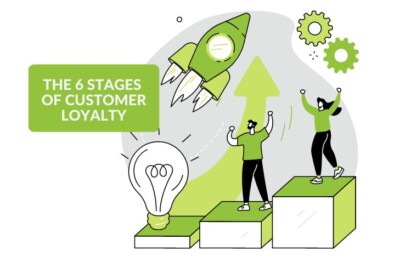What Are the 6 Stages of Customer Loyalty, and How to Use Them to Your Advantage?
Just like in Rome, you can’t build customer loyalty in a day. Customer loyalty creates social engagement between your customers and your company’s products or service. It goes beyond a one-time purchase to fostering a long-term relationship between you and your customers.
Customer loyalty is the measure of the possibility of a customer conducting repeat business with your company through satisfaction when engaging with your products or services. However, understanding who your loyal customers are and developing strategies that will help you maintain them is crucial for the growth and existence of every business. bLoyal helps entrepreneurs and businesses of all sizes to identify, reward, and create the best loyalty programs.
After understanding the concept behind customer loyalty, our marketers have identified 6 stages every customer goes through before becoming loyal. From suspect to prospect, first-time customer, repeat customer, client, and finally to advocate. So let’s get started!

6 Stages of Customer Loyalty.
1. Suspect.
The suspect stage addresses customers you presume currently need your services or products. You must use the best marketing techniques to turn suspects’ attention toward your brand. We live in a world full of new ideas with countless brand advertising their products and services at the same time. Stand out from the crowd by developing the most suitable marketing and promotion strategy to help you effectively market your company. Posting marketing ads on different social media platforms has proved efficient, with 44% of brand consumers purchasing after seeing an ad online. Creating an easy-to-understand and share advert that relates to your target audience’s needs will attract a large audience, increasing your brand awareness.
2. Prospect.
A prospect is a potential customer who requires your products or services but is yet to purchase. You must nurture your prospects to convert them into paying customers. Know your prospective customers’ lifestyle needs and create irresistible offers matching their wants.
3. First-time customer.
When you turn your prospect into a first-time customer, you need to continuously engage and nurture them to increase your customer’s lifetime value. Let your customers know they can trust your brand. Providing good customer service and real-time communication through email marketing or SMS is essential. It creates a sense of trust between you and your first-time consumers, driving them to make repeat purchases.
4. Repeat customer.
Customers want to be recognized and appreciated. Creating a personalized experience with your customers makes them feel valued. Rewarding your customers with amazing discounts, promotions, and exciting deals encourages them to know that every transaction with your company is worth more than monetary value.
5. Client.
A client is a committed buyer who consistently purchases your products or services. During this stage, you must continue building and maintaining your relationship with your customer, maintaining contact, and adding value so that they only think of you whenever they need your services. As a marketer, you can achieve this by inviting your clients to join your brand’s loyalty programs.
6. Advocate.
At this stage, your loyal customer turns into your brand advocates. Clients that have positively engaged with your company tend to market your brand by word-of-mouth (WOM). They recommend you to their friends through social media posts, feedback, referrals, and sharing positive comments. Note that 83% of consumers trust recommendations from family or friends.
However, to earn the best advocacy from your clients, you should:
- Offer valuable feedback and review comments from your customers in real-time on a personal level.
- Have a top-notch online presence, especially for eCommerce businesses. (Facebook, Instagram, Twitter, etc.).
- Engage with your audience and educate them about your brand.
To effectively determine and assess your first-time, prospective, and repeat customers, you can conduct data analysis and segment customers based on their recent purchase behavior.
Tracking your net promoter score will also help you measure your brand performance, determine the percentage of customer promoters, and gauge overall customer satisfaction with your brand from captured feedback.
Strategies to move from one stage to the next stage.
● Offer next-purchase and sign-up discounts for potential returning customers.
Offering next-purchase discounts help retain your first-time customers by encouraging them to sign up and return to earn discounts. Moreover, when customers sign up, you collect relevant personal data that aid in marketing communication and post-purchase follow-ups.
● Always encourage the next purchase.
Rewarding customers with surprise discounts will drive them to make repeat purchases. Offering free shipping from your eCommerce store for purchases above a cost range will encourage your customers to purchase more.
● Offer a loyalty program for repeat customers and clients.
Offering a loyalty program shows appreciation to your customers. Creating a loyalty program with different stages and reward points will encourage customers to purchase more, unlocking the next rewards level and earning more discounts.
● Offer a referral program for advocates.
A referral program tracks data, attracts new customers and rewards your best customers. Offering reward points and discounts for every referral maximizes customer referrals and helps you attract more customers.
Bottom line!
The road to long-term customer loyalty is ensuring you use the best techniques, enterprise tools, loyalty support, and reward programs from bLoyal. Regardless of your business size, we will help you build customer loyalty and increase your customer lifetime value (CLV) and revenue. Please email us at info@bloyal.com or call 1.877.869.1715 and request a free demo.




